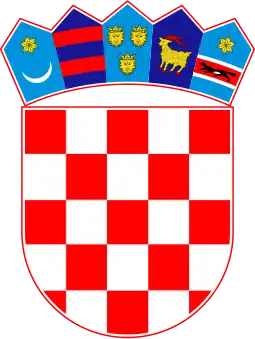| Medvedgrad | |
|---|---|
| Zagreb Croatia | |
 Medvedgrad | |
| Coordinates | 45°52′11″N 15°56′28″E / 45.86972°N 15.94111°E |
| Type | Castle |


Medvedgrad (pronounced [mědʋedɡraːd]; Croatian for bear-town; Hungarian: Medvevár) is a medieval fortified town located on the south slopes of Medvednica mountain, approximately halfway from the Croatian capital Zagreb to the mountain top Sljeme. For defensive purposes it was built on a hill, Mali Plazur, that is a spur of the main ridge of the mountain that overlooks the city. On a clear day the castle can be seen from far away, especially the high main tower. Below the main tower of the castle is Oltar Domovine (Altar of the homeland) which is dedicated to Croatian soldiers killed in the Croatian War of Independence.[1][2]
History
In 1242, Mongols invaded Zagreb. The city was destroyed and burned to the ground. This prompted the building of Medvedgrad.[3] Encouraged by Pope Innocent IV, Philip Türje, bishop of Zagreb, built the fortress between 1249 and 1254. It was later owned by bans of Slavonia. Notable Hungarian poet and Ban of Slavonia Janus Pannonius (1472), and Ban of Croatia Ivan Karlović (1531), died in the Medvedgrad castle.
The last Medvedgrad owners and inhabitants was the Gregorijanec family, who gained possession of Medvedgrad in 1562. In 1574, the walls of Medvedgrad were reinforced, but after the 1590 Neulengbach earthquake, the fortress was heavily damaged and the owners relocated to Šestine.[4][5]: 638 It was reduced to ruins, along with the Veliki Kalnik fortress in Križevci, by the 1699 Metlika earthquake.[5]: 638 [6] It remained in this state until the late 20th century, when it was partly restored and now offers a panoramic view of the city from an elevation of over 500 meters (1,600 ft).
Name
The name Medvedgrad in Croatian is a compound word consisting of medved — the Kajkavian dialectal variant of Standard Croatian medvjed — meaning "bear" and grad, meaning "town, city" today, but it used to mean a fortified castle. It can be roughly translated as "Beartown", "Bear City", or more accurately "Bear Castle".
References
- ↑ Zagreb Convention Bureau
- ↑ Contagious Middle Ages Exhibit Archived 2007-04-20 at archive.today
- ↑ Mašić, Boris. "7. Medvedgrad". Zagreb City Museum. Archived from the original on 3 May 2018. Retrieved 14 August 2015.
- ↑ Radauš, Tatjana (2002). "Gregorijanec". Croatian Biographical Lexicon. Miroslav Krleža Institute of Lexicography. Retrieved 14 August 2015.
- 1 2 Simović, Veselin (11 December 2000). "Potresi na zagrebačkom području" [Earthquakes in the Zagreb area]. Građevinar (in Croatian). 52 (11): 637–645. ISSN 0350-2465. Retrieved 1 November 2021.
- ↑ "Močni potresi v preteklosti" (PDF) (in Slovenian). Slovenian Environment Agency. 4 November 2017. Retrieved 1 November 2021.
Further reading
- Tomičić, Antonija (2014). "Povijest medvedgradske utvrde" (PDF). Essehist (in Croatian). 6 (6): 37–47. Retrieved 22 April 2020.

